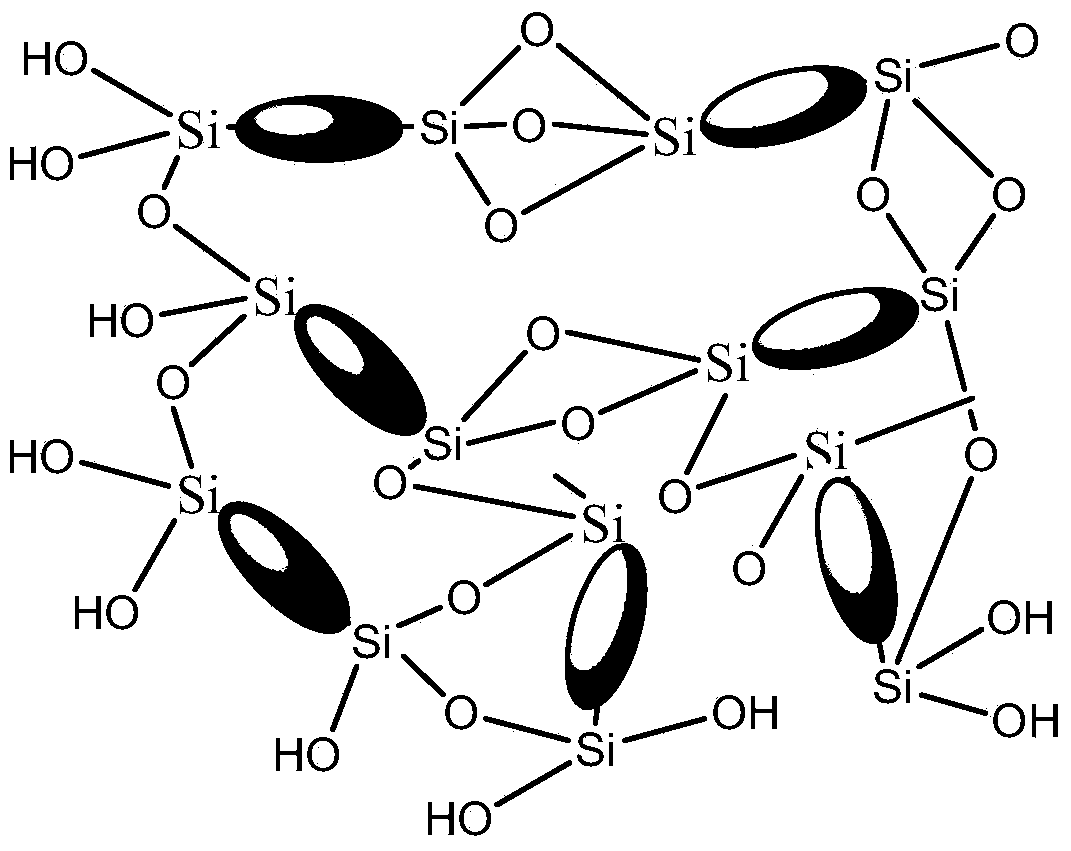Bridged polysilsesquioxane microspheres
A technology of polysilsesquioxane and microspheres, which is applied in the preparation of microspheres, microcapsule preparations, silicon organic compounds, etc., can solve the problems of large size dispersion, low yield, and high size uniformity, and achieve uniform size High stability, simple process and easy production, less side effects
- Summary
- Abstract
- Description
- Claims
- Application Information
AI Technical Summary
Problems solved by technology
Method used
Image
Examples
Embodiment 1
[0026] Step 1. Under nitrogen protection, under constant temperature conditions of 60°C, mix 60mL of ethanol with a volume concentration of 95% or more, 3mL of tetramethylammonium hydroxide and 100mL of ammonia water with a concentration of 5mol / L, and then stir evenly to obtain a mixed solution;
[0027] Step 2. Under the protection of nitrogen, under the condition of constant temperature stirring at 60 ° C, 50 mL of bridging bistrimethoxysilane (1,2-bis(trimethoxysilyl) ethane with ethyl as the bridging group) ) was added dropwise to the mixed solution described in step 1, and after the dropwise addition was completed, reflux and stirred for 12h, and then the reaction solution was filtered to obtain a white solid crude product; the 1,2-bis(trimethoxysilyl)ethane Molecular formula is
[0028] Step 3. Wash the crude white solid product described in step 2 with deionized water and acetone three times in sequence, and then vacuum-dry the crude white solid product after washing...
Embodiment 2
[0031] Step 1. Under nitrogen protection, under constant temperature conditions of 50°C, mix 80mL of ethanol with a volume concentration of 95% or more, 4mL of tetramethylammonium hydroxide and 80mL of ammonia water with a concentration of 10mol / L, and then stir evenly to obtain a mixed solution;
[0032] Step 2, under the protection of nitrogen, under the condition of constant temperature stirring at 50 ° C, 60 mL of bridged bistrichlorosilane (1,8-bis(trichlorosilyl) n-octane) with n-octyl as the bridging group ) is added dropwise to the mixed solution described in step 1, after the dropwise addition is completed, reflux and stir for 15h, then the reaction solution is filtered to obtain a white solid crude product; the 1,8-bis(trichlorosilyl) n-octane Molecular formula is
[0033] Step 3. Wash the crude white solid product described in step 2 with deionized water and acetone four times in sequence, and then vacuum-dry the crude white solid product after washing to obtain a...
Embodiment 3
[0036] Step 1. Under nitrogen protection, under constant temperature conditions of 70°C, mix 90mL of acetone with a volume concentration of 95% or more, 5mL of tetraethylammonium hydroxide and 100mL of ammonia water with a concentration of 3mol / L, and then stir evenly to obtain a mixed solution;
[0037] Step 2. Under the protection of nitrogen, under the condition of constant temperature stirring at 70 ° C, 100 mL of bridged bistrimethoxysilane (1,4-bis(trimethoxysilyl) benzene) with phenyl as the bridging group Add it dropwise to the mixed solution described in step 1, reflux and stir for 5 hours after the dropwise addition is completed, then filter the reaction solution to obtain a white solid crude product; the molecular formula of the 1,4-bis(trimethoxysilyl)benzene is
[0038] Step 3. The white solid crude product described in step 2 is washed twice with deionized water and acetone in turn, and then the washed white solid crude product is vacuum-dried to obtain a white po...
PUM
 Login to View More
Login to View More Abstract
Description
Claims
Application Information
 Login to View More
Login to View More - R&D
- Intellectual Property
- Life Sciences
- Materials
- Tech Scout
- Unparalleled Data Quality
- Higher Quality Content
- 60% Fewer Hallucinations
Browse by: Latest US Patents, China's latest patents, Technical Efficacy Thesaurus, Application Domain, Technology Topic, Popular Technical Reports.
© 2025 PatSnap. All rights reserved.Legal|Privacy policy|Modern Slavery Act Transparency Statement|Sitemap|About US| Contact US: help@patsnap.com


